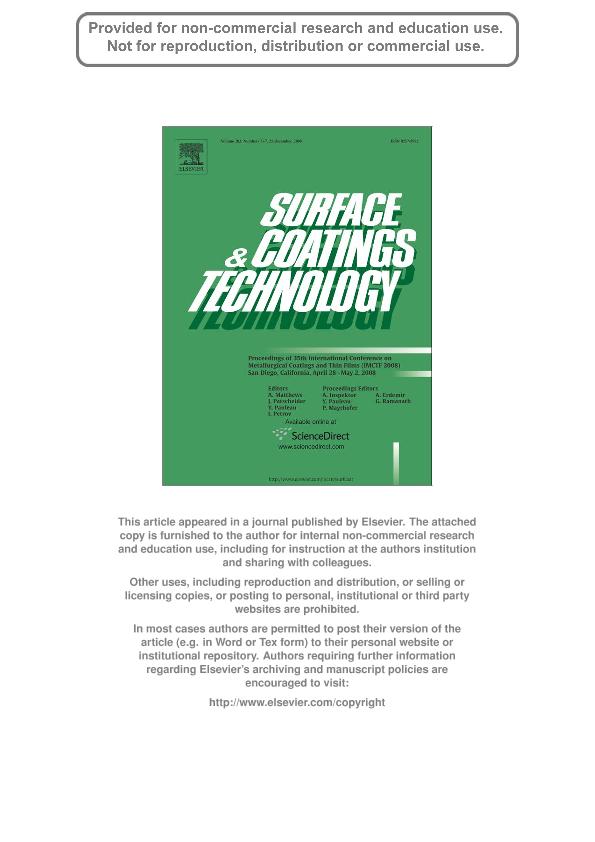Mostrar el registro sencillo del ítem
dc.contributor.author
Carr, Gustavo Eduardo

dc.contributor.author
Conde, Raul Horacio

dc.date.available
2019-01-07T17:06:46Z
dc.date.issued
2008-12
dc.identifier.citation
Carr, Gustavo Eduardo; Conde, Raul Horacio; Tribology of hard coating alloys deposited by thermal methods: Applications to industrial components; Elsevier Science Sa; Surface and Coatings Technology; 203; 5-7; 12-2008; 685-690
dc.identifier.issn
0257-8972
dc.identifier.uri
http://hdl.handle.net/11336/67565
dc.description.abstract
In most of seamless tube making industries, the useful life of mandrels for rotary forging is less than 350 perforation events; though in some cases, the tool may last longer than 1000 perforations. Being the first of a series of hot working steps, improvement during the piercing multiplies the benefits throughout the whole manufacturing process. Mandrels are cast in three metal bases: iron, nickel and cobalt; though lower costs support the use of iron base alloys, mostly when larger mandrel diameters are required. Mandrels lifespan is usually improved by the controlled growth, at high temperature, of a hard oxide film. The research reported in this work is related to the protective oxide films grown on mandrels for seamless tube rotary forging.22The present work is part of G.E. Carr's Ph.D. Thesis at Univesidad Nacional de Mar del Plata, Argentina. A laboratory-scale equipment has been entirely designed and built at INTEMA in order to study mandrels wear during the rotary piercing of steel billets. Hard coating oxides grown under a controlled atmosphere on mandrels surface were tested by this equipment, reproducing the wear conditions observed at industrial scale. Wear and oxide film evolution were studied by optical microscopy and energy-dispersive X-ray spectroscopy. Acquired data from lab-scale piercing experiments were analyzed using neural networks (self-organizing maps) to discover relationships among the 22 process parameters and the oxide film characteristics. This method of analysis may well be applied to any industrial component under multivariable hard coating wear conditions.
dc.format
application/pdf
dc.language.iso
eng
dc.publisher
Elsevier Science Sa

dc.rights
info:eu-repo/semantics/openAccess
dc.rights.uri
https://creativecommons.org/licenses/by-nc-nd/2.5/ar/
dc.subject
High Temperature
dc.subject
Oxides
dc.subject
Rotary Piercing
dc.subject
Tribology
dc.subject
Wear
dc.subject.classification
Recubrimientos y Películas

dc.subject.classification
Ingeniería de los Materiales

dc.subject.classification
INGENIERÍAS Y TECNOLOGÍAS

dc.title
Tribology of hard coating alloys deposited by thermal methods: Applications to industrial components
dc.type
info:eu-repo/semantics/article
dc.type
info:ar-repo/semantics/artículo
dc.type
info:eu-repo/semantics/publishedVersion
dc.date.updated
2019-01-02T18:27:56Z
dc.journal.volume
203
dc.journal.number
5-7
dc.journal.pagination
685-690
dc.journal.pais
Países Bajos

dc.journal.ciudad
Amsterdam
dc.description.fil
Fil: Carr, Gustavo Eduardo. Consejo Nacional de Investigaciones Científicas y Técnicas. Centro Científico Tecnológico Conicet - Mar del Plata. Instituto de Investigaciones en Ciencia y Tecnología de Materiales. Universidad Nacional de Mar del Plata. Facultad de Ingeniería. Instituto de Investigaciones en Ciencia y Tecnología de Materiales; Argentina
dc.description.fil
Fil: Conde, Raul Horacio. Universidad Nacional de Mar del Plata. Facultad de Ingeniería. Departamento de Mecanica; Argentina
dc.journal.title
Surface and Coatings Technology

dc.relation.alternativeid
info:eu-repo/semantics/altIdentifier/doi/http://dx.doi.org/10.1016/j.surfcoat.2008.08.061
dc.relation.alternativeid
info:eu-repo/semantics/altIdentifier/url/https://www.sciencedirect.com/science/article/pii/S0257897208008074
Archivos asociados
